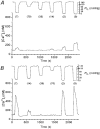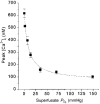Resetting and postnatal maturation of oxygen chemosensitivity in rat carotid chemoreceptor cells
- PMID: 9852330
- PMCID: PMC2269068
- DOI: 10.1111/j.1469-7793.1999.493ae.x
Resetting and postnatal maturation of oxygen chemosensitivity in rat carotid chemoreceptor cells
Abstract
1. Carotid chemoreceptor sensitivity is minimal immediately after birth and increases with postnatal age. In the present study we have investigated the peri- and postnatal developmental time course of [Ca2+]i responses to hypoxia in clusters of type I cells isolated from near-term fetal rats and rats that were 1, 3, 7, 11, 14 and 21 days old, using the Ca2+-sensitive fluoroprobe fura-2. 2. In type I cells from all age groups a graded increase in [Ca2+]i occurred in response to lowering the PO2 from 150 mmHg to 70, 35, 14, 7, 2 and 0 mmHg. The graded [Ca2+]i response to hypoxia was hyperbolic at all ages. 3. Type I cells from rats near-term fetal to 1 day old exhibited small [Ca2+]i responses, mainly to the most severe levels of hypoxia. After day 1, an increase in the [Ca2+]i responses to submaximal hypoxia stimulation resulted in a rightward shift in the O2 response curve. Using the Delta[Ca2+]i between 35 and 2 mmHg PO2 as an index of O2 sensitivity, type I cell O2 sensitivity increased approximately 4- to 5-fold between near-term fetal to 1 day old and 11 to 14 days of age. 4. Exposure to elevated extracellular potassium (10, 20 and 40 mM K+) caused a dose-dependent [Ca2+]i rise in type I cells from all age groups. There were no age-related changes in [Ca2+]i responses to any level of K+ between near-term fetal and 21 days. 5. We conclude that the maximal type I cell [Ca2+]i response to anoxia, as well as the sensitivity to submaximal hypoxic stimulation, of rats aged from near-term fetal to 21 days depends on the level of postnatal maturity. The lack of an age-related increase in the [Ca2+]i response to elevated K+ during the timeframe of maximal development of O2 sensitivity suggests that resetting involves maturation of O2 sensing, rather than non-specific developmental changes in the [Ca2+]i rise resulting from depolarization.
Figures









Similar articles
-
Postnatal development of E-4031-sensitive potassium current in rat carotid chemoreceptor cells.J Appl Physiol (1985). 2005 Apr;98(4):1469-77. doi: 10.1152/japplphysiol.01254.2003. Epub 2004 Dec 10. J Appl Physiol (1985). 2005. PMID: 15591286
-
Chronic hypoxia abolished the postnatal increase in carotid body type I cell sensitivity to hypoxia.Am J Physiol. 1999 Sep;277(3):L645-52. doi: 10.1152/ajplung.1999.277.3.L645. Am J Physiol. 1999. PMID: 10484473
-
Hypoxia induces voltage-dependent Ca2+ entry and quantal dopamine secretion in carotid body glomus cells.Proc Natl Acad Sci U S A. 1994 Oct 11;91(21):10208-11. doi: 10.1073/pnas.91.21.10208. Proc Natl Acad Sci U S A. 1994. PMID: 7937863 Free PMC article.
-
Postnatal development of carotid body glomus cell O2 sensitivity.Respir Physiol Neurobiol. 2005 Nov 15;149(1-3):201-15. doi: 10.1016/j.resp.2005.04.009. Respir Physiol Neurobiol. 2005. PMID: 15886071 Review.
-
Mechanisms of carotid chemoreceptor resetting after birth. In vitro studies.Adv Exp Med Biol. 1996;410:73-7. doi: 10.1007/978-1-4615-5891-0_9. Adv Exp Med Biol. 1996. PMID: 9030279 Review.
Cited by
-
Effects of modulators of AMP-activated protein kinase on TASK-1/3 and intracellular Ca(2+) concentration in rat carotid body glomus cells.Respir Physiol Neurobiol. 2014 May 1;195:19-26. doi: 10.1016/j.resp.2014.01.020. Epub 2014 Feb 13. Respir Physiol Neurobiol. 2014. PMID: 24530802 Free PMC article.
-
Chronic hypoxia upregulates the expression and function of proinflammatory cytokines in the rat carotid body.Histochem Cell Biol. 2008 Sep;130(3):549-59. doi: 10.1007/s00418-008-0437-4. Epub 2008 May 1. Histochem Cell Biol. 2008. PMID: 18446360
-
Changes in oxygen sensitivity of TASK in carotid body glomus cells during early postnatal development.Respir Physiol Neurobiol. 2011 Aug 15;177(3):228-35. doi: 10.1016/j.resp.2011.04.012. Epub 2011 Apr 16. Respir Physiol Neurobiol. 2011. PMID: 21530688 Free PMC article.
-
Ca2+ oscillations in rat carotid body type 1 cells in normoxia and hypoxia.Am J Physiol Cell Physiol. 2020 Feb 1;318(2):C430-C438. doi: 10.1152/ajpcell.00442.2019. Epub 2020 Jan 8. Am J Physiol Cell Physiol. 2020. PMID: 31913694 Free PMC article.
-
Respiratory responses to hypoxia during rest and exercise in individuals born pre-term: a state-of-the-art review.Eur J Appl Physiol. 2022 Sep;122(9):1991-2003. doi: 10.1007/s00421-022-04965-9. Epub 2022 May 19. Eur J Appl Physiol. 2022. PMID: 35589858 Review.
References
-
- Acker H. Mechanisms and meaning of cellular oxygen sensing in the organism. Respiration Physiology. 1994;95:1–10. 10.1016/0034-5687(94)90043-4. - DOI - PubMed
MeSH terms
Substances
Grants and funding
LinkOut - more resources
Full Text Sources
Medical
Miscellaneous

